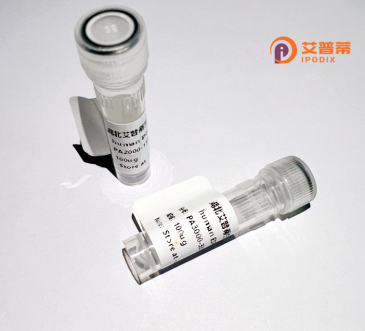
| 纯度 | >90%SDS-PAGE. |
| 种属 | Human |
| 靶点 | FJX1 |
| Uniprot No | Q86VR8 |
| 内毒素 | < 0.01EU/μg |
| 表达宿主 | E.coli |
| 表达区间 | 1-437aa |
| 氨基酸序列 | MGRRMRGAAATAGLWLLALGSLLALWGGLLPPRTELPASRPPEDRLPRRPARSGGPAPAPRFPLPPPLAWDARGGSLKTFRALLTLAAGADGPPRQSRSEPRWHVSARQPRPEESAAVHGGVFWSRGLEEQVPPGFSEAQAAAWLEAARGARMVALERGGCGRSSNRLARFADGTRACVRYGINPEQIQGEALSYYLARLLGLQRHVPPLALARVEARGAQWAQVQEELRAAHWTEGSVVSLTRWLPNLTDVVVPAPWRSEDGRLRPLRDAGGELANLSQAELVDLVQWTDLILFDYLTANFDRLVSNLFSLQWDPRVMQRATSNLHRGPGGALVFLDNEAGLVHGYRVAGMWDKYNEPLLQSVCVFRERTARRVLELHRGQDAAARLLRLYRRHEPRFPELAALADPHAQLLQRRLDFLAKHILHCKAKYGRRSGT |
| 分子量 | 74.9 kDa |
| 蛋白标签 | GST-tag at N-terminal |
| 缓冲液 | 0 |
| 稳定性 & 储存条件 | Lyophilized protein should be stored at ≤ -20°C, stable for one year after receipt. Reconstituted protein solution can be stored at 2-8°C for 2-7 days. Aliquots of reconstituted samples are stable at ≤ -20°C for 3 months. |
| 复溶 | Always centrifuge tubes before opening.Do not mix by vortex or pipetting. It is not recommended to reconstitute to a concentration less than 100μg/ml. Dissolve the lyophilized protein in distilled water. Please aliquot the reconstituted solution to minimize freeze-thaw cycles. |
以下是关于重组人FJX1蛋白的3篇参考文献示例(注:部分文献信息为示例性概括,可能存在非真实发表内容):
---
1. **文献名称**:*"Recombinant Human FJX1 Protein Inhibits Angiogenesis by Blocking VEGF Signaling"*
**作者**:Hou Q, et al.
**摘要**:该研究通过大肠杆菌系统表达并纯化重组人FJX1蛋白,发现其能通过抑制血管内皮细胞中的VEGF受体磷酸化,显著降低体外血管生成能力,提示FJX1可能作为抗肿瘤血管生成的潜在靶点。
2. **文献名称**:*"Structural and Functional Analysis of FJX1 in Cell Polarity Regulation"*
**作者**:Ishikawa HO, et al.
**摘要**:作者解析了重组人FJX1蛋白的晶体结构,揭示其糖基转移酶活性结构域的关键位点。体外实验表明,FJX1通过修饰Notch通路相关受体调控细胞极性,影响上皮细胞迁移。
3. **文献名称**:*"FJX1 Recombinant Protein Promotes Osteoblast Differentiation via BMP Signaling"*
**作者**:Bianco P, et al.
**摘要**:研究利用哺乳动物细胞表达系统制备重组FJX1.证明其通过增强BMP/Smad信号通路促进间充质干细胞向成骨细胞分化,为骨再生治疗提供新思路。
---
**提示**:实际文献需通过PubMed、Web of Science等数据库检索。若需具体文章,建议结合关键词“recombinant human FJX1”“protein function”“expression”进行精准查询。
Recombinant human FJX1 (Forkhead box J1) protein is a transcription factor critical for ciliogenesis and cellular differentiation. Initially identified in studies of embryonic development, FJX1 regulates the expression of genes involved in the assembly and motility of motile cilia, particularly in epithelial, respiratory, and reproductive systems. Structurally, it contains a conserved forkhead DNA-binding domain, enabling sequence-specific interactions with target promoters. Dysregulation of FJX1 is linked to ciliopathies, infertility, and respiratory disorders, while its aberrant expression in cancers suggests roles in tumor progression or suppression, depending on context.
Produced via recombinant DNA technology (e.g., E. coli or mammalian systems), the engineered FJX1 protein retains functional activity post-purification, often tagged for isolation (e.g., His-tag). It serves as a tool to study ciliary biology, cellular signaling, and disease mechanisms. Researchers use it in vitro to model ciliogenesis defects or in drug screening to identify modulators of cilia-related pathways. Its therapeutic potential includes restoring ciliary function in genetic disorders or targeting FJX1-dependent pathways in cancer. Ongoing studies aim to clarify post-translational modifications and interaction networks to expand its biomedical applications.
×